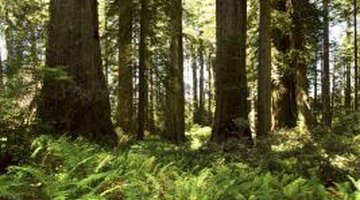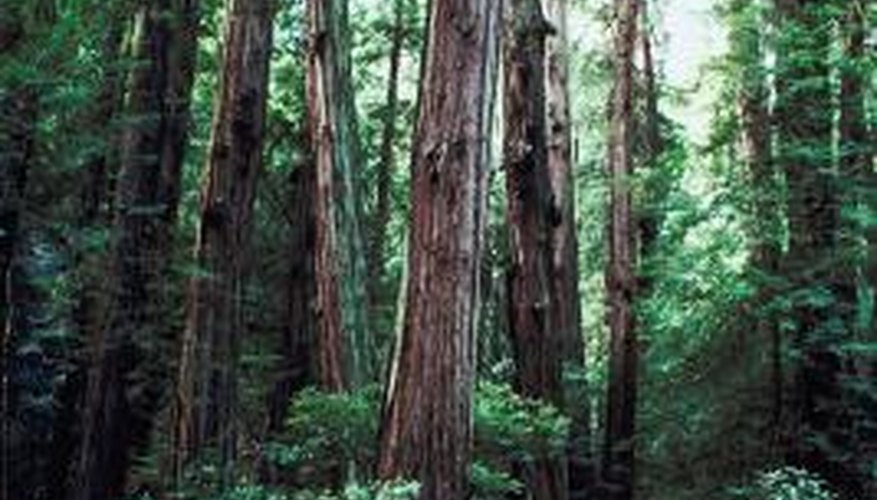Coniferous forests are biomes of conifers or evergreen trees. The boreal forest or taiga is the largest coniferous forest in the world, extending throughout the Northern Hemisphere from the tundra of Canada and Alaska into northern Asia and Europe. Coniferous forests consist of three layers of vegetation: the canopy, shrub and ground layers. Each layer houses the specific species of plant life that create the coniferous biome.
Forest Layers
The coniferous forest, like all forests, exists in layers from the canopy to the forest floor. Tall evergreen trees, such as pine, spruce and hemlock, create the canopy of a coniferous biome. These trees withstand the extreme temperatures of the Northern Hemisphere. Small deciduous trees and bushes make up the shrub layer of the forest, while ferns, mosses and acid-tolerant wildflowers form the ground layer. Each layer is home to wildlife that cannot exist elsewhere.
- The coniferous forest, like all forests, exists in layers from the canopy to the forest floor.
Canopy Layer
The trees of the canopy layer are evergreens, which are a softwood highly sought after in construction as well as furniture making. Clear-cutting of coniferous trees causes environmental disasters such as landslides and extinction of wildlife. While forest fires devastate evergreen forests, the heat of the fire is necessary for new life to begin. Species of conifers such as redwood must have extreme heat to open their seedpods. Evergreens house and feed numerous birds and small animals within the forest.
- The trees of the canopy layer are evergreens, which are a softwood highly sought after in construction as well as furniture making.
- While forest fires devastate evergreen forests, the heat of the fire is necessary for new life to begin.
Shrub Layer

Beaked hazel, mountain maple, honeysuckle and dogwood are some of the shrubs that grow in the acid soil beneath conifers. These shrubs provide food for the small herbivores that live in the forest. They are shade-tolerant. Mountain laurel and rhododendron exhibit beautiful floral displays in the conifer forests in areas like the Blue Ridge Mountains where moderate temperatures allow for longer growing periods. Blueberries and sheep laurel grow beneath the conifers in the taiga.
- Beaked hazel, mountain maple, honeysuckle and dogwood are some of the shrubs that grow in the acid soil beneath conifers.
Ground Layer
The floor of the coniferous forest teams with life. Mosses and lichens that date back to prehistory grow in profusion due to the dark, moist environment found in the forest floor. Ferns and wildflowers thrive in the acid soil of evergreen forests. In the bogs of the taiga, cranberries, small orchids and pitcher plants prosper. Pitcher plants, also known as insect-eating plants, deter insect population growth. Many of the plants from this layer have healing properties that native people used in medicine.
- The floor of the coniferous forest teams with life.
- Mosses and lichens that date back to prehistory grow in profusion due to the dark, moist environment found in the forest floor.
